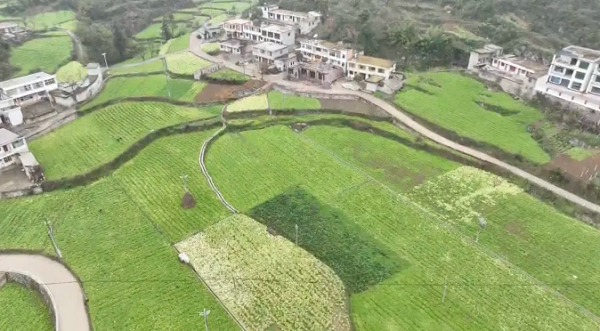Guiyang and Gui'an ensure stable winter vegetable supply
As winter vegetable production reaches a critical phase, Guiyang City and Gui'an New Area in Southwest China's Guizhou province are implementing targeted strategies to ensure stable supplies and price stability.
Measures include creating specialized vegetable-growing villages, adopting efficient planting models, accelerating the development of standardized vegetable bases, and providing technical training to enhance agricultural practices.

An aerial view of farm fields in Guiyang and Gui'an. [Photo/WeChat account of Zhizhi Guiyang]
In Hongxing village, Xiuwen county, over 1,200 mu (80 hectares) of cabbage sprouts are flourishing. Farmers are busy harvesting, while traders transport fresh produce to markets across Guiyang and Gui'an. Local farmer Sun Guangjin reports a daily output of 150 kilograms from his 12.8-mu field, with earnings of approximately 1,000 yuan ($137.02) per day due to favorable market prices.
This year, Guiyang and Gui'an have upgraded 100,000 mu of vegetable demonstration bases to bolster production capacity. For example, in Machang village of Huaxi district, a vibrant green onion farm now supplies 150 metric tons daily, accounting for 60 percent of Guiyang's green onion market.
Modern farming methods, such as "rice-vegetable rotation" and "grain-vegetable intercropping", maximize land use during winter and improve efficiency. Currently, 53,000 mu is under cultivation, supporting farmers' incomes and residents' tables.
Standardized facilities, such as advanced greenhouses and irrigation systems, play a vital role. Guizhou Tonghong Juxin Agricultural Development Company alone expects to supply 750,000 kg of vegetables annually.
To date, Guiyang and Gui'an have planted 128,000 mu of vegetables, ensuring a daily supply of 5,000 tons. Future efforts will focus on scaling production, optimizing planting structures, and adopting sustainable practices to secure a steady vegetable supply.
Presented by China Daily.
黔ICP备05001922号-3
